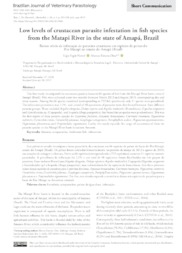Low levels of crustacean parasite infestation in fish species from the Matapi River in the state of Amapá, Brazil.
Low levels of crustacean parasite infestation in fish species from the Matapi River in the state of Amapá, Brazil.
Autoria: NEVES, L. R.; TAVARES-DIAS, M.
Resumo: This first study investigated the crustacean parasite fauna in 66 species of fish from the Matapi River basin, state of Amapá (Brazil). Fish were collected every two months between March 2012 and August 2013, encompassing dry and rainy seasons. Among the 66 species examined (corresponding to 722 fish specimens) only 11 species were parasitized. The infestation prevalence was 2.2%, and a total of 48 specimens of parasites were distributed between three different parasite groups. These included Argulus elongatus, Dolops reperta and Argulus multicolor (Branchiura), Ergasilus xinguensis and Gamidactylus sp. (Copepoda), and Isopoda (Braga patagonica), but branchiuran species were predominant. This was the first report of these parasite species for Leporinus fasciatus, Astyanax bimaculatus, Curimata incompta, Pygocentrus nattereri, Crenicichla cincta, Crenicichla johanna, Geophagus camopiensis, Pterophyllum scalare, Plagioscion squamosissimus, Hypostomus plecostomus and Propimelodus eigenmanni. Lastly, this study expands the range of occurrence of these six parasite species to the Matapi River basin in eastern Amazon.
Ano de publicação: 2019
Tipo de publicação: Artigo de periódico
Unidade: Embrapa Amapa
Palavras-chave: Amazonia, Ectoparasites, Freshwater fish, Infestation, Parasito de Animal, Peixe de Água Doce
Observações
1 - Por padrão são exibidas publicações dos últimos 20 anos. Para encontrar publicações mais antigas, configure o filtro ano de publicação, colocando o ano a partir do qual você deseja encontrar publicações. O filtro está na coluna da esquerda na busca acima.
2 - Para ler algumas publicações da Embrapa (apenas as que estão em formato ePub), é necessário ter, no celular ou computador, um desses softwares gratuitos. Sistemas Android: Google Play Livros; IOS: iBooks; Windows e Linux: software Calibre.
Acesse outras publicações
Acesse a Base de Dados da Pesquisa Agropecuária (BDPA) para consultar o acervo completo das bibliotecas da Embrapa.

